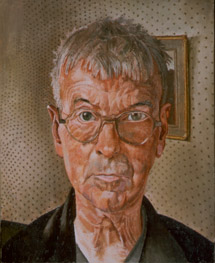Sir Stanley Spencer | |
|---|---|
 Self-portrait, 1959 | |
| Born | 30 June 1891 Cookham, England |
| Died | 14 December 1959 (aged 68) Cliveden, Buckinghamshire, England |
| Education |
|
| Known for | Painting, drawing |
| Notable work | The Resurrection, Cookham |
| Awards | RA 1950; CBE 1950; Knighted 1959 |
| Patron(s) | Louis and Mary Behrend |
Sir Stanley Spencer, CBE RA (30 June 1891 – 14 December 1959) was an English painter. Shortly after leaving the Slade School of Art, Spencer became well known for his paintings depicting Biblical scenes occurring as if in Cookham, the small village beside the River Thames where he was born and spent much of his life. Spencer referred to Cookham as "a village in Heaven" and in his biblical scenes, fellow-villagers are shown as their Gospel counterparts. Spencer was skilled at organising multi-figure compositions such as in his large paintings for the Sandham Memorial Chapel and the Shipbuilding on the Clyde series, the former being a First World War memorial while the latter was a commission for the War Artists' Advisory Committee during the Second World War.
As his career progressed Spencer often produced landscapes for commercial necessity and the intensity of his early visionary years diminished somewhat while elements of eccentricity came more to the fore. Although his compositions became more claustrophobic and his use of colour less vivid he maintained an attention to detail in his paintings akin to that of the Pre-Raphaelites.[1] Spencer's works often express his fervent if unconventional Christian faith. This is especially evident in the scenes that he based in Cookham which show the compassion that he felt for his fellow residents and also his romantic and sexual obsessions. Spencer's works originally provoked great shock and controversy. Nowadays, they still seem stylistic and experimental, while the nude works depicting his futile relationship with his second wife, Patricia Preece, such as the Leg of mutton nude, foreshadow some of the much later works of Lucian Freud. Spencer's early work is regarded as a synthesis of French Post-Impressionism, exemplified for instance by Paul Gauguin, plus early Italian painting typified by Giotto.[2] In later life Spencer remained an independent artist and did not join any of the artistic movements of the period, although he did show three works at the Second Post-Impressionist Exhibition in 1912.[3]
- ^ Frances Spalding (1990). 20th Century Painters and Sculptors. Antique Collectors' Club. ISBN 1-85149-106-6.
- ^ Museum of New Zealand Te Papa Tongarewa (2005). Treasures from the Museum of New Zealand Te Papa Tongarewa. Te Papa Press. p. 56. ISBN 1-877385-12-3.
- ^ Cite error: The named reference
Edwardianswas invoked but never defined (see the help page).